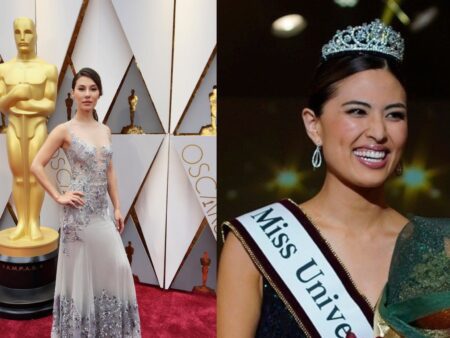Looking at how infertility is reflected in books, TV shows, and glossy magazines, you might never guess who this condition really affects, as a whole. Usually, the ‘barren’ woman is depicted as a white woman “past her prime” reproductive years—which is to say older than thirty-five to forty years old. But this medical issue doesn’t discriminate when it comes to race, gender, religion, sexual orientation, socio-economic status, age, lifestyle, or other factors.
So what does infertility really look like, across the population? This is What Infertility Looks Like, a campaign organized by pregnantish founder, relationship expert and author Andrea Syrtash, with support from First Response™ Pregnancy, aims to shine critical light on the long-overlooked faces and voices of this disease, which affects an estimated 12-15% of the population, and help promote greater understanding and awareness of what it means to struggle to grow a family, for millions of individuals and couples across America each year.
One reason this is important, says Syrtash, is because “Not seeing anyone who looks like you reflected in the conversation makes an isolating experience that much more isolating.”
People of Color Have Higher Rates of Infertility, Often Left Untreated
Of the many who have for too long been underrepresented or left out of the infertility conversation almost completely are people of color. In fact, some conditions that can cause infertility – like fibroid tumors, endometriosis and PCOS – are more prominent in these communities, even when undiagnosed or treated.
Dr. Roohi Jeelani, a fertility doctor currently undergoing IVF to expand her family adds that there’s a cultural stigma in the South Asian community. “We are bred to think we can have a baby when we’re ready. It’s important to show how many this disease affects,” Jeelani asserts.
Campaign cast member and patient advocate Brittney Cain believes that while “historically the fertility treatment conversations are centered around upper-class white women, it’s important to normalize discussing infertility especially in marginalized groups.”
Cain, an African American woman in her 30’s living in Atlanta with her husband Doug and their toddler Kai, had symptoms as early as 17 and 18 years old but wasn’t diagnosed with PCOS until she was struggling to conceive.
She is one of countless women of color who, when undergoing fertility treatments and trying to conceive, relied on trusted and available pregnancy tests, like First Response™, to help navigate both the emotional and physical rollercoaster of challenges, joys, and continued unknowns. “I felt like if I got the news on my own time it would ease the blow of being blindsided by a nurse with results. After every cycle, the night before the blood test, I would do a test myself,” Cain says. “By the time we got to a transfer that worked, I started to see (the home pregnancy test) as the first hurdle in a different part of the journey to baby. I learned to stop and embrace that this moment in time is good news and to celebrate all the wins as they come,” Cain relates.
First Response™ has supported the infertility community for decades with its long-standing partnership with RESOLVE, the National Infertility Association and annual programs dedicated to the community during National Infertility Awareness Week each year. This year, First Response™ has teamed up with pregnantish to increase awareness around fertility issues with the new campaign. “It’s critical to show the many faces and stories of infertility, as this program offers just a glimpse into the general lack of understanding and misconceptions people have about this medical issue. We applaud the incredible people speaking out in this campaign, and in turn, lifting and empowering others that may be going through something similar,” says Eileen Hsu, Director of Marketing for First Response™.
Men Need to Be Included in the Conversation
Men make up another almost entirely overlooked population in the infertility conversation, even though they account for up to half of all cases.
Air Force Sergeant Christian Borrero-Colon, born with non-obstructive azoospermia, a genetic abnormality caused by a lack of sperm, shares his experience as part of the inclusion campaign to assure other hopeful fathers and couples that they aren’t alone in their struggles. “Infertility isn’t something people associate with men. It made me question my masculinity and made me insecure, even though I was born with this issue,” said Christian.
Even for couples’ whose infertility isn’t caused by issues with sperm, people in heterosexual relationships going through treatments like IVF are in in together. Too often, men are left out when we address an infertility audience, even though they report stress, anxiety and feelings of confusion and uncertainty around how to navigate this roadblock in growing a family.
Infertility Doesn’t Only Affect Women Over 35
Age is another common misconception about infertility. While many believe the problem largely affects women who have simply waited too long (and of course it’s true that egg quality declines in a woman each year), a large number of cases are caused by pre-existing or genetic conditions unrelated to age.
Campaign cast member and elite marathon runner Kelly McLay suffered from premature ovarian failure due to an autoimmune disorder. “This thrust me into early, full-blown menopause beginning around 20 years of age,” she explains. “If people were to look at me today, you would not see any of the years of struggle and the feeling of being 80 when I was 20…. Infertility in a woman is not always about age,” McLay emphasizes. People “see me holding my two littles and cannot see the years it took to get close to this picture. I think it just goes to show that everyone is dealing with something in the background,” and it’s important for others not to “judge a book by its cover,” she adds.
As she fought to navigate her infertility battle and in order to feel more confident, McLay ran 70 marathons to prove to herself that she was still strong in her body. Even then, she shares, “I was often criticized and scrutinized,” McLay recounts, instead of understood or supported. McLay adds that many who didn’t know her full medical history judged her and believed her marathon running caused her infertility.
LGBTQ Are Accessing Fertility Treatments, Too
The LGBTQ community also needs to be better accounted for in fertility studies and literature. According to the 2020 US Census numbers, of the millions of LGBTQ individuals in the country, hundreds of thousands are raising kids.
Fitness instructor and advocate Tracy Palmer found that “you mostly find success rates and other information for IUI & IVF for women in heterosexual relationships experiencing infertility. (And) I think this is where queer fertility research and literature is lacking. We did 5 rounds and 6 IUIs (one cycle we did 2 IUIs) at home with a midwife before we moved to a fertility clinic and medicated cycles.”
Palmer adds that although it has been difficult for them to get pregnant and experience a miscarriage, they have not been diagnosed as infertile. “Everything is “normal” and I’m “healthy.” As a same sex couple, we just start from a tougher place with frozen sperm and less flexibility with timing,” she explains, illustrating the frustration and lack of support too often reflected in same-sex couples or gay individuals trying to grow a family.
Access to Treatment is a Financial Challenge for Too Many
As ESPN anchor Nicole Briscoe and her husband, race-car driver Ryan Briscoe know well, being able to afford fertility treatment is only the first step in trying to grow a family, while struggling with fertility issues—a step that doesn’t even guarantee a child. Briscoe joins the pregnantish campaign in support of the millions of couples and individuals struggling financially to simply access or begin treatment, whose hefty price tag averages anywhere from $15,000 to $25,000, and up, including all the drugs and services patients require. The CDC estimates that between 12-15% of people struggling with fertility are left without access to treatment, leaving many hopeful parents out of the picture. With greater awareness of fertility issues and prohibitive treatment costs, many more could benefit from the life-changing medical advancements now available to some, but not all, who yearn to raise a family of their own.
As these brave and determined campaign cast members’ personal infertility stories illustrate here, when we think and talk about this struggle affecting millions trying to build a family, it’s critical that we view and portray the issue through a wider, more accurate and inclusive lens. Showing a diverse range of patients in both research and medical studies as well as in literature and on the silver screen will not only help raise awareness and understanding, but also go a long way to supporting the infertility community as a whole.
Contributor
Lorraine Allen
Lorraine Allen is a writer, educator and mom to a tween, a toddler, and a hyperactive puppy. Her writing on parenthood and childhood development has appeared in The New York Times, The Wall Street Journal, The Washington Post, and Parents magazine, among other publications. Follow her on Twitter @LorraineAwriter

Listen to stories, share your own, and get feedback from the community.


















